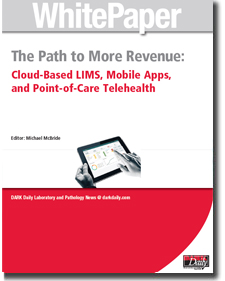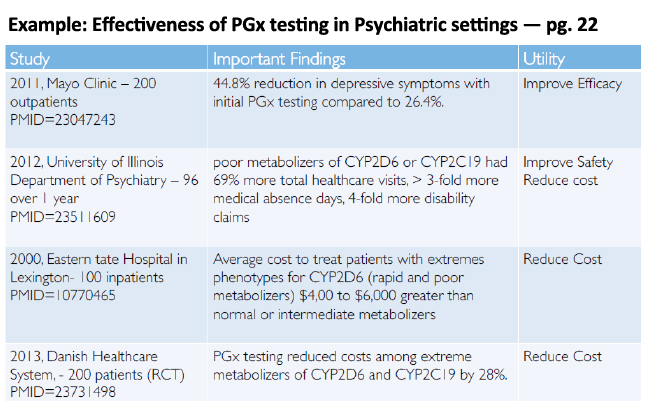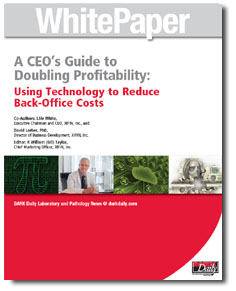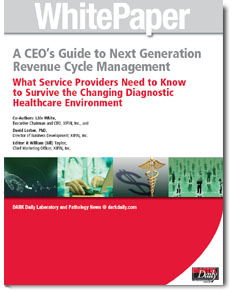
The Path to More Revenue: Cloud-Based LIMS, Mobile Apps, and Point-of-Care Telehealth
The shift from a traditional fee-for-service model to value-based healthcare requires a completely new approach for clinical labs to help clients improve their quality of care, enhance their workflow processes, and maintain viable revenue streams.
In combination with the newly enacted PAMA reductions in reimbursement rates, it is more critical than ever for hospital, commercial, and outreach laboratories to partner with companies that have the proven competence to help them thrive in this new environment.
 Your lab and care workflows depend on LIS efficiency. Scalability of the LIS determines your practice’s growth. Not to mention the ability of your LIS to capably interface with and support new technologies and new value-based Medicare Quality Payment Programs (QPPs) such as the MACRA Merit-based Incentive Payments System (MIPS). Fact is, the performance capability of your laboratory’s LIS goes way beyond its ability to participate in these new value-based care initiatives—the right LIS is critical to your practice to ensure success and increased revenue.
Your lab and care workflows depend on LIS efficiency. Scalability of the LIS determines your practice’s growth. Not to mention the ability of your LIS to capably interface with and support new technologies and new value-based Medicare Quality Payment Programs (QPPs) such as the MACRA Merit-based Incentive Payments System (MIPS). Fact is, the performance capability of your laboratory’s LIS goes way beyond its ability to participate in these new value-based care initiatives—the right LIS is critical to your practice to ensure success and increased revenue.
The good news is that thanks to advances in laboratory information management systems and cloud-based technology, as a provider you now have unprecedented opportunities to better manage the health of patients, promote adherence to treatments, as well as to reduce costs.
This FREE White Paper addresses:
- Overview of the new technologies and value-based programs: their objectives, along with potential impacts to your lab
- How the right LIS solution can help you potentially significantly reduce hospital readmission rates and experience favorable parameters reported to CMS
- How effecting these improvements can help bridge the gap between labs, physicians, and other healthcare providers
- How, in addition, you can achieve better efficiency, economics, and compliance with MACRA
- Why many labs are now turning to an LIS such as the NeTLIMS LabOS system, which helps streamline the collection of information in both the lab and care environments
- How working together with the right LIS vendor can serve to positively affect patient outcomes, facilitate reporting of quality measures, and maximize reimbursement for all services on specific patient care teams
Table of Contents: Introduction
Chapter 1: Medicare Quality Payment Programs and Value-based Care
Chapter 2: What Is the MACRA Quality Payment Program?
Chapter 3: What Is the MIPS Reimbursement Track?
Chapter 4: How Does MACRA/MIPS Impact Medical Laboratories Revenue?
Chapter 5: Using NeTLIMS LabOS LIS to Foster Healthy Outcomes
Chapter 6: LabOS Supports Value-based Care through Seamless Integration and Scalability
Chapter 7: LabWay App: NeTLIMS Mobile Product Delivers Value-based Care to Patients Even in Remote Locations
Chapter 8: LabOS, LabWay, and MIPS Points
Chapter 9: Achieving Goals for Value-Based Care Using LabOS and LabWay
Chapter 10: NeTLIMS LabOS and LabWay Define Value-based Care
Chapter 11: How Point-of-Care Telehealth Solutions Reduce Hospital Readmissions
Chapter 12: How Do Digital Therapeutics Benefit Medical Laboratories?
Chapter 13: Telehealth and Chronic Disease Management
Chapter 14: NeTLIMS LabWay and Care Trek
Conclusion Potential Savings and Revenue Increase A quality LIS vendor should define the way technology assists in maintaining a patient’s overall health and happiness, and thrive on delivering accurate results in the fastest time possible. This is so that providers, medical staff, and laboratories can improve their work processes in the delivery of patient care which are, of course, objectives which in turn provide revenue enhancements for labs. This FREE white paper can help inform your LIS decision-making. Download your FREE copy of “The Path to More Revenue: Cloud-Based LIMS, Mobile Apps, and Point-of-Care Telehealth.”
Download the White Paper now by completing the form below.
Access to some white papers may require registration. In exchange for providing this free content, we may share your information with the companies whose content you choose to view. By accessing the white paper, you’re agreeing to our Terms of Service and Privacy Policy.





 Although the value of PGx testing is abundantly clear, it does present a number of challenges to physicians, clinical diagnostic laboratories, and healthcare institutions. A primary challenge is the difficulty of analyzing the complex amount of information involved in PGx testing and comparing it to the drugs the patient is being prescribed—and then turning that information into actionable intelligence that a busy physician can use to drive good medical care, in a cost-effective, efficient and reliable manner. This FREE downloadable White Paper discusses practical ways in which healthcare providers can hurdle these, and other obstacles, and will provide you with a detailed discussion regarding the importance of PGx testing in today’s healthcare environment. After reviewing it, you will possess a greater understanding of the obstacles physicians, laboratories and hospitals face when launching a pharmacogenomics program, how PGx testing can be used to drive patient care, and the important role cloud-based software can play in making PGx testing a practical and cost-effective solution.
Although the value of PGx testing is abundantly clear, it does present a number of challenges to physicians, clinical diagnostic laboratories, and healthcare institutions. A primary challenge is the difficulty of analyzing the complex amount of information involved in PGx testing and comparing it to the drugs the patient is being prescribed—and then turning that information into actionable intelligence that a busy physician can use to drive good medical care, in a cost-effective, efficient and reliable manner. This FREE downloadable White Paper discusses practical ways in which healthcare providers can hurdle these, and other obstacles, and will provide you with a detailed discussion regarding the importance of PGx testing in today’s healthcare environment. After reviewing it, you will possess a greater understanding of the obstacles physicians, laboratories and hospitals face when launching a pharmacogenomics program, how PGx testing can be used to drive patient care, and the important role cloud-based software can play in making PGx testing a practical and cost-effective solution.









